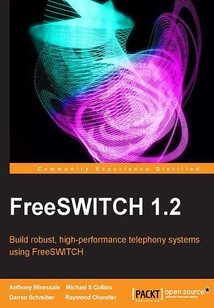舉報(bào) 

會(huì)員
FreeSWITCH 1.2
最新章節(jié):
Index
Thisbookisfullofpracticalcodeexamplesaimedatabeginnertoeasehisorherlearningcurve.ThisbookiswrittenforITprofessionalsandenthusiastswhoareinterestedinquicklygettingapowerfultelephonysystemupandrunningusingthefreeandopensourceapplication,FreeSWITCH.Telephonyexperiencewillbehelpful,butnotrequired.
目錄(149章)
倒序
- 封面
- 版權(quán)信息
- Credits
- About the Authors
- About the Reviewers
- www.PacktPub.com
- Preface
- Chapter 1. Architecture of FreeSWITCH
- A revolution has begun and secrets have been revealed
- The FreeSWITCH design – modular scalable and stable
- Important modules – Endpoint and Dialplan
- Complex applications made simple
- Summary
- Chapter 2. Building and Installation
- Setting up the FreeSWITCH environment
- Operating system prerequisites
- Text editors and XML
- Downloading the source
- Building from the latest code
- Compiling FreeSWITCH for Linux/Unix/Mac OS X
- Compiling FreeSWITCH for Windows
- Starting FreeSWITCH
- Running FreeSWITCH in the background
- Summary
- Chapter 3. Test Driving the Example Configuration
- Important concepts to understand
- Putting FreeSWITCH to work
- Configuring a SIP phone to work with FreeSWITCH
- Testing the example Dialplan
- Summary
- Chapter 4. SIP and the User Directory
- Understanding the FreeSWITCH user directory
- Working with the FreeSWITCH user directory
- User features
- Adding a user
- Testing voicemail
- Groups of users
- Connecting to the world with gateways
- SIP profiles and user agents
- Summary
- Chapter 5. Understanding the XML Dialplan
- FreeSWITCH XML Dialplan elements
- Contexts
- Extensions
- Call legs and channel variables
- Accessing channel variables
- Regular expressions
- Actions and anti-actions
- How Dialplan processing works
- Creating a new extension
- Important Dialplan applications
- Dialstring formats
- Summary
- Chapter 6. Using XML IVRs and Phrase Macros
- IVR engine overview
- IVR XML configuration file
- IVR engine overview
- Using phrases with IVRs
- Advanced routing
- Summary
- Chapter 7. Dialplan Scripting with Lua
- Getting started with Lua
- Basic Lua syntax
- Building voice applications
- Advanced IVR concepts
- Scripting tips
- Summary
- Chapter 8. Advanced Dialplan Concepts
- Dialplan overview
- General Diaplan concepts
- Putting it all together
- XML Dialplan module review
- Pitfalls to avoid
- XML Dialplan applications
- Utilizing variables
- Global variables
- Dialplan functions
- Set export and legs
- Passing variables via call headers
- XML Dialplan cookbook
- Summary
- Chapter 9. Moving Beyond the Static XML Configuration
- The mod_xml_curl basics
- The mod_xml_curl Dialplan
- The mod_xml_curl folder
- The mod_xml_curl configuration
- The mod_xml_curl summary
- Generating configurations dynamically with language bindings
- Making calls from the command line interface
- Using ESL to execute commands
- Summary
- Chapter 10. Controlling FreeSWITCH Externally
- General overview
- Event system architecture
- Event-based modules
- Sending events
- Events from the Dialplan
- FreeSWITCH event system commands
- FreeSWITCH Console application
- Event Socket Library
- Events in practice
- Summary
- Chapter 11. Web-based Call Control with mod_httapi
- HTTAPI syntax
- mod_httapi configuration file
- The demo IVR – in HTTAPI
- Summary
- Chapter 12. Handling NAT
- A brief introduction to NAT
- The four pitfalls of NAT
- Demystifying NAT settings in FreeSWITCH
- Making media flow
- Advanced options and settings
- FreeSWITCH on the client side
- Other creative uses of FreeSWITCH in a NAT situation
- Conclusion
- Summary
- Chapter 13. VoIP Security
- Network level protection
- Protecting SIP signalling
- Protecting audio
- Protecting passwords
- Summary
- Chapter 14. Advanced Features and Further Reading
- Multi-user conferencing
- Nibblebill
- Alternative endpoints
- Configuration tools and related projects
- Web GUIs
- Supporting libraries
- Vestec Automatic Speech Recognition
- Summary
- Appendix A. The FreeSWITCH Online Community
- The FreeSWITCH mailing lists
- Talking in real time via IRC
- The FreeSWITCH main website and wiki
- The annual ClueCon open source developer conference
- Appendix B. Migrating from Asterisk to FreeSWITCH
- Getting started
- Configuration files
- Two SIP phones
- Voicemail
- Summary
- Appendix C. The History of FreeSWITCH
- Taking things to the next level
- New ideas and a new project
- The first ClueCon
- Introducing FreeSWITCH
- Index 更新時(shí)間:2021-08-20 16:56:13
推薦閱讀
- 計(jì)算機(jī)網(wǎng)絡(luò)與通信(第2版)
- 廣電5G從入門到精通
- 物聯(lián)網(wǎng)與北斗應(yīng)用
- Building E-commerce Sites with VirtueMart Cookbook
- EDA技術(shù)與VHDL編程
- 計(jì)算機(jī)網(wǎng)絡(luò)與數(shù)據(jù)通信
- SSL VPN : Understanding, evaluating and planning secure, web/based remote access
- 企業(yè)網(wǎng)絡(luò)安全管理
- IPv6網(wǎng)絡(luò)切片:使能千行百業(yè)新體驗(yàn)
- 搶占下一個(gè)智能風(fēng)口:移動(dòng)物聯(lián)網(wǎng)
- 4G小基站系統(tǒng)原理、組網(wǎng)及應(yīng)用
- 一本書讀懂物聯(lián)網(wǎng)
- 轉(zhuǎn)化:提升網(wǎng)站流量和轉(zhuǎn)化率的技巧
- 沖擊:5G如何改變世界
- 智能物聯(lián)安防視頻技術(shù)基礎(chǔ)與應(yīng)用
- 智慧的物聯(lián)網(wǎng):感知中國(guó)和世界的技術(shù)
- 云計(jì)算、網(wǎng)絡(luò)安全和網(wǎng)絡(luò)盜竊:網(wǎng)絡(luò)世界防盜初學(xué)指南
- 5G重塑數(shù)字化未來
- 局域網(wǎng)組建與維護(hù)項(xiàng)目教程
- 計(jì)算機(jī)網(wǎng)絡(luò)技術(shù)實(shí)用寶典(第3版)
- Citrix XenDesktop 5.6 Cookbook
- 創(chuàng)新力:中國(guó)網(wǎng)絡(luò)創(chuàng)新研究
- iOS 12 Programming for Beginners
- 中國(guó)互聯(lián)網(wǎng)發(fā)展報(bào)告(2010)
- INSTANT RESS Implementation How-to
- 無處不在的網(wǎng)絡(luò)
- 計(jì)算機(jī)網(wǎng)絡(luò)管理原理與實(shí)現(xiàn)
- Learn Microsoft PowerApps
- SpamAssassin: A practical guide to integration and configuration
- 網(wǎng)絡(luò)信息安全實(shí)訓(xùn)

